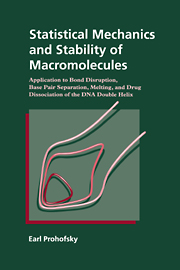 Statistical Mechanics and Stability of Macromolecules
Statistical Mechanics and Stability of Macromolecules Book contents
- Frontmatter
- Contents
- Preface
- 1 Introduction
- 2 Macromolecular stability
- 3 Lattice dynamics
- 4 Effective phonon theory
- 5 Premelting disrupted chemical bonds
- 6 Cooperative melting
- 7 Strained chemical bonds: salt and pressure effects
- 8 Bond disruption and conformation change: B to Z conformation change in DNA
- 9 Hydration effects: structural water
- 10 Helix with daunomycin intercalated: increased helix stability and daunomycin-DNA binding constant
- 11 Nonrepeating DNA
- 12 Cutting and splicing: junctions, inserts, and the replicating fork
- 13 Interaction between a helix and a single attached molecule
- 14 Energy considerations in bond opening
- Appendix 1 Helical lattice dynamics
- Appendix 2 Density matrix and effective phonon theory
- Appendix 3 Green functions
- References
- Index
10 - Helix with daunomycin intercalated: increased helix stability and daunomycin-DNA binding constant
Published online by Cambridge University Press: 16 September 2009
- Frontmatter
- Contents
- Preface
- 1 Introduction
- 2 Macromolecular stability
- 3 Lattice dynamics
- 4 Effective phonon theory
- 5 Premelting disrupted chemical bonds
- 6 Cooperative melting
- 7 Strained chemical bonds: salt and pressure effects
- 8 Bond disruption and conformation change: B to Z conformation change in DNA
- 9 Hydration effects: structural water
- 10 Helix with daunomycin intercalated: increased helix stability and daunomycin-DNA binding constant
- 11 Nonrepeating DNA
- 12 Cutting and splicing: junctions, inserts, and the replicating fork
- 13 Interaction between a helix and a single attached molecule
- 14 Energy considerations in bond opening
- Appendix 1 Helical lattice dynamics
- Appendix 2 Density matrix and effective phonon theory
- Appendix 3 Green functions
- References
- Index
Summary
Greater helix
The study of the dynamics of a helix with elements, such as a drug, attached to it is easiest when there is an excess of the element so that it forms a repeating pattern of attachment. This allows the use of lattice methods to solve the large dimensional problem associated with the long helix. When only one element (or a few elements) attaches to a long helix the study is best handled by methods developed in Chapters 11 and 13. One of the more extensively studied attaching drugs is daunomycin, probably because it is an important antitumor agent. It is one of a number of drugs that intercalate into the helix, i.e. part of it has a planar structure that enters between base pairs of the helix. The specific example studied is the repeating unit of daunomycin–poly(GCAT)–poly(ATGC) (Chen and Prohofsky, 1994). The calculation determines the probability of the drug dissociating from the DNA helix which can be converted to give the binding constant of the drug to the helix. The choice of the particular DNA sequence was dictated by the availability of X-ray conformational information (Wang et al., 1987). The helix is somewhat distorted by the intercalation and the calculation uses the distorted conformation and the correct daunomycin position. The bases are numbered in the unit cell by calling the first guanine G1 then proceeding down one strand in the 3′ to 5′ direction so that the next cytosine is C2, then comes A3 and T4.
- Type
- Chapter
- Information
- Statistical Mechanics and Stability of MacromoleculesApplication to Bond Disruption, Base Pair Separation, Melting, and Drug Dissociation of the DNA Double Helix, pp. 137 - 145Publisher: Cambridge University PressPrint publication year: 1995


